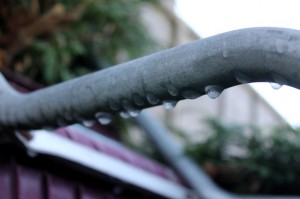
Ice Dams
You may have seen buildings with sheets of icicles hanging off their roofs. These are called “ice dams,” and they form when snow and ice build up on a rooftop. The upper layers insulate the lower layers, and the melted water runs down the roof until it reaches the open air where it freezes into the icicles. This new layer of ice forms a dam that blocks any further water from draining, causing it to build up and eventually leak through the roof. Depending on the extent of the build-up, the dam can also cause further water damage when it inevitably melts. Some ways to limit the threat of water damage from ice dams include:
- Keep the gutters clean so that the melted water can flow out and not form a dam.
- Instal a water-repellent membrane under the roof covering. This won’t stop a dam from forming but will limit leak potential.
- Keep the attic well ventilated to maintain a low temperature and reduce melting and refreezing. Similarly, a well-insulated attic won’t allow much heat to escape to melt ice and snow on the roof.
- Remove snow and ice build-ups on the roof, or hire an expert to do it for you.
- Salt the roof to prevent freezing.
Freezing Pipes
Water expands when it freezes. Although pipes are designed to allow for a bit of freezing, if it happens en masse, like during a cold snap, the pressure build-up can cause the pipe to burst. This most often happens in cases where the water has not been allowed to flow, such as in houses left empty on vacation. The pipes in thin or exterior-bordering parts of the home—such as attics, crawl spaces, and outside walls—are especially vulnerable, though any pipe can be affected. The following methods can prevent your pipes from bursting:
- Make sure all pipes near the home’s exterior are properly insulated. You can also fit any exposed piping with insulation sleeves to further protect them.
- Seal any holes in exterior walls. These holes are regularly drilled for things like cable or telephone lines, but they provide openings for cold air to flow into the walls.
- If you are planning to leave on vacation, locate and shut off your property’s main water valve. You should still keep at least one faucet turned on to allow any water still in the system to get pushed out in event of freezing.
- Let a dribble of water run through at least one faucet on each floor. This will keep the water circulating through the pipes and reduce the likelihood of freezing.
The Thaw
Warmer days will eventually come, but all that snow and ice still has to go somewhere when it melts. When the temperature rises and the snow melts, all that water can damage your property because drainage systems overload by the sudden deluge. The steps to reduce water damage and flooding risk from a spring thaw are similar to those you’d use to prevent storm flooding:
- Check any storm drains for obstructions, and make sure there is a clear path for meltwater to travel. Don’t assume that the snow closest to the grates will melt first, either.
- Keep gutters and eaves clear of obstruction and ice build-up.
- Shovel snow away from vulnerable areas of the house, such as basement windows or sections where the grade slants towards your property.
- Check the masonry for small cracks and fill as necessary.
- Make sure you secure roof shingles and gutters in place. Shifting ice and snow can be surprisingly strong and can knock something loose. In addition to requiring costly repairs, this also deprives you of a drainage mechanism.
Flood Services Canada is a leader in flood remediation along with mould, sewage backup, clean-up, and fire and smoke damage clean-up. Our rapid response teams can quickly get to work to both prevent and mitigate flood and leak damage and aid in the restoration process. Contact us at (416) 302-2107 to learn more about how to protect your property, or use our emergency hotline at (416) 999-3930 to get our rapid response teams deployed to your area.
